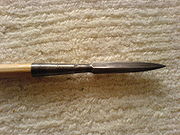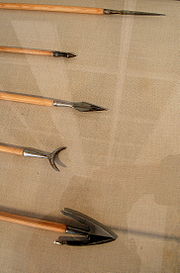
Bodkin point
Encyclopedia


Arrowhead
An arrowhead is a tip, usually sharpened, added to an arrow to make it more deadly or to fulfill some special purpose. Historically arrowheads were made of stone and of organic materials; as human civilization progressed other materials were used...
. In its simplest form it is an uncomplicated squared metal spike, and was used extensively during the Middle Ages
Middle Ages
The Middle Ages is a periodization of European history from the 5th century to the 15th century. The Middle Ages follows the fall of the Western Roman Empire in 476 and precedes the Early Modern Era. It is the middle period of a three-period division of Western history: Classic, Medieval and Modern...
. The typical bodkin was a square-section arrowhead, generally up to 4½" (11.5cm) long and ⅜" (1 cm) thick at its widest point, tapered down behind this initial "punch" shape. Bodkin arrows complemented traditional broadhead arrows, which continued to be used, as the sharp, wide cutting surface of the broadhead caused more serious wound
Wound
A wound is a type of injury in which skin is torn, cut or punctured , or where blunt force trauma causes a contusion . In pathology, it specifically refers to a sharp injury which damages the dermis of the skin.-Open:...
s and tissue damage than the bodkin arrowhead.
History
The name comes from the Old English word bodkin or bodekin, a type of sharp, pointed daggerDagger
A dagger is a fighting knife with a sharp point designed or capable of being used as a thrusting or stabbing weapon. The design dates to human prehistory, and daggers have been used throughout human experience to the modern day in close combat confrontations...
. Arrows of the long bodkin type were used by the Vikings and were continued to be used through the Middle Ages. The bodkin point eventually fell out of use during the 16th and 17th centuries. Firearms were beginning to dominate the battlefield and would make infantry armour largely obsolete in the coming centuries, though it was still used to a limited extent as late as the First World War
Cuirassier
Cuirassiers were mounted cavalry soldiers equipped with armour and firearms, first appearing in late 15th-century Europe. They were the successors of the medieval armoured knights...
.
Armour penetration
It has been suggested that the bodkin came into its own as a means of penetrating armour, but research by the Royal Armouries has found no hardened bodkin points, though only two bodkin points were actually tested, not a statistically relevant number. Bodkins did, however, have greater ability to pierce mail armour than broadheads, and historical accounts do speak of bodkin arrows shot from close range piercing plate armour. Broadheads were made from steel, sometimes with hardened edges, but were more often used against lightly armoured men or horses than against an armoured adversary.In a modern test, a direct hit from a steel bodkin point penetrated Damascus chain armour, although at point blank range. However, the test was conducted without a padded jack or gambeson
Gambeson
A gambeson is a padded defensive jacket, worn as armour separately, or combined with mail or plate armour. Gambeson were produced with a sewing technique called quilting. Usually constructed of linen or wool, the stuffing varied, and could be for example scrap cloth or horse hair...
, which was layered cloth armor worn over heavier armor for protection against projectiles, as it was known to stop even heavy arrows. Furthermore, and despite the author's assertion, the penetration ability of the arrow would decline according to the distance it has traveled due to drag
Drag
- In science and technology :* Drag , the force which resists motion of an object through a fluid* Drag equation, a mathematical equation used in analyzing the magnitude of drag caused by fluid flow...
. Lastly, a human body standing will give, another factor not accounted for in this experiment.
Armour of the Medieval eras was not completely proof against arrows until the specialized armour of the Italian city-state mercenary companies. Archery was thought not to be effective against plate armour
Plate armour
Plate armour is a historical type of personal armour made from iron or steel plates.While there are early predecessors such the Roman-era lorica segmentata, full plate armour developed in Europe during the Late Middle Ages, especially in the context of the Hundred Years' War, from the coat of...
in the Battle of Neville's Cross
Battle of Neville's Cross
The Battle of Neville's Cross took place to the west of Durham, England on 17 October 1346.-Background:In 1346, England was embroiled in the Hundred Years' War with France. In order to divert his enemy Philip VI of France appealed to David II of Scotland to attack the English from the north in...
(1346), the siege of Bergerac
Battle of Bergerac
The Battle of Bergerac was fought in August 1345. An Anglo-Gascon Army commanded by Henry of Grosmont, Earl of Derby, defeated a French force under Henri de Montigny, Seneschal of Périgord, outside the walls of Bergerac, leading to the loss of the town...
(1345), and the Battle of Poitiers (1356)
Battle of Poitiers (1356)
The Battle of Poitiers was fought between the Kingdoms of England and France on 19 September 1356 near Poitiers, resulting in the second of the three great English victories of the Hundred Years' War: Crécy, Poitiers, and Agincourt....
; such armour became available to European knights of fairly modest means by the late 14th century, though never to all soldiers in any army.
Some recent tests have demonstrated that needle bodkins could penetrate all but heavy steel plate armour; one test used padded "jack" armour, coat of plates, iron and steel mail and steel plate. A needle bodkin penetrated every type, but may not have been able to inflict a lethal injury behind plate.

